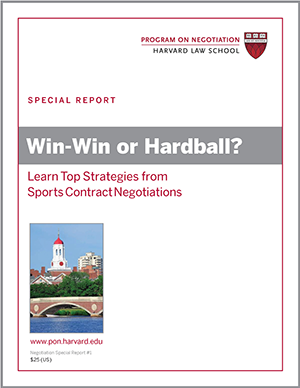
In business negotiation, a win-win agreement may be the ultimate goal, but it can sometimes prove elusive. Here, we offer four strategies from experts at the Program on Negotiation at Harvard Law School on how to create win-win situations in even the trickiest negotiations.
1. Try Joint Fact-Finding.
When you are pursuing a goal that threatens the status quo, the opposition is typically fierce. At such times, you might think that the key to a win-win contract is to try to enlighten your counterparts about how the proposed goal will further the common good.
This view is flat-out wrong, writes Massachusetts Institute of Technology professor Lawrence Susskind in his book Good for You, Great for Me: Finding the Trading Zone and Winning at Win-Win Negotiation (PublicAffairs, 2014). When you communicate one-sided information about a project’s merits, you’ll come across as arrogant and oblivious to the other party’s concerns.
By contrast, a joint fact-finding process provides a better route to a win-win situation. It begins by engaging negotiators in a collaborative exploration of a project’s feasibility and merits during its earliest stages, with the help of outside experts, before everyone begins taking sides. Whenever parties are likely to disagree on the fundamental issues at stake, enlisting outside help for an unbiased view of the facts can be a crucial first step toward reaching a win-win deal.
2. Create More Value Through Trades.
When determining how to create win-win situations, one promising strategy is to look for ways to find more value through trades, writes Susskind. First, prepare to present multiple proposals—all of which you value highly—to your counterpart at the same time. Her reactions to these proposals will help you better gauge her preferences across issues. Second, ask lots of questions to directly assess her interests and reveal your own. Third, make hypothetical “What if…” proposals to determine if a trade genuinely creates value for both sides, such as “If I offered you a 5% discount on our new product, would that be enough of an incentive for you to switch from our existing product?”
3. Try Contingent Agreements.
In negotiation, it’s common for parties to reach an impasse because they have different beliefs about the likelihood of future events. You might be convinced that your firm will deliver a project on time and under budget, for example, but the client may view your proposal as unrealistic. In such situations, a contingent agreement—negotiated “if, then” promises aimed at reducing risk about future uncertainty—offers a way for parties to agree to disagree—and achieve a win-win situation in business. You might propose paying specified penalties for turning your project in late or agree to significantly lower your rates if you go over budget, for example.
To add a contingent agreement to your contract, begin by having both sides write out their own scenarios of how they expect the future to unfold. Then negotiate expectations and requirements that seem appropriate to each scenario. Finally, include both the scenarios and the negotiated repercussions and rewards in your contract.
4. Consider Adding a Matching Right.
Granting a buyer the right to match or improve upon another bidder’s offer within a set period of time can help answer the question of how to create win-win situations for both buyer and seller, according to Harvard Business School and Harvard Law School professor Guhan Subramanian. Such matching rights, or rights of first refusal, give buyers the opportunity to stay in the game and sellers a chance to explore their options. Matching rights can be incorporated into all types of deals across industries.
Because matching rights are often imprecisely worded in contracts, however, they can create new problems. It may be unclear, for example, if a buyer will end the contest when it matches a third party’s bid or if the match will trigger a bidding war. Similarly, matching rights may limit, or appear to limit, the competition to a single issue: price. This fact can constrain buyers from competing on other issues and sellers from shopping for the best all-around deal. Finally, when adding matching rights to their contracts, buyers often overlook the importance of having ample time to decide whether to match a competitor’s offer. So don’t blindly accept your lawyer’s boilerplate language on matching rights. Instead, negotiate for terms that will lessen your odds of overbidding if a contest arises down the road.
Can you think of other advice on how to create win-win situations?






When looking for the win-win, always balance value-added accommodation at low or no cost with long-term interests. Clients tend to embrace the idea of lengthening agreements to avoid the costs associated with RFPs, RFQs, and long bidding cycles.